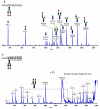Analytical glycobiology at high sensitivity: current approaches and directions
- PMID: 22945852
- PMCID: PMC3586546
- DOI: 10.1007/s10719-012-9444-8
Analytical glycobiology at high sensitivity: current approaches and directions
Abstract
This review summarizes the analytical advances made during the last several years in the structural and quantitative determinations of glycoproteins in complex biological mixtures. The main analytical techniques used in the fields of glycomics and glycoproteomics involve different modes of mass spectrometry and their combinations with capillary separation methods such as microcolumn liquid chromatography and capillary electrophoresis. The need for high-sensitivity measurements have been emphasized in the oligosaccharide profiling used in the field of biomarker discovery through MALDI mass spectrometry. High-sensitivity profiling of both glycans and glycopeptides from biological fluids and tissue extracts has been aided significantly through lectin preconcentration and the uses of affinity chromatography.
Figures














Similar articles
-
Recent trends in analytical and structural glycobiology.Curr Opin Chem Biol. 2013 Oct;17(5):832-40. doi: 10.1016/j.cbpa.2013.05.029. Epub 2013 Jun 18. Curr Opin Chem Biol. 2013. PMID: 23790311 Free PMC article. Review.
-
Towards structure-focused glycoproteomics.Biochem Soc Trans. 2021 Feb 26;49(1):161-186. doi: 10.1042/BST20200222. Biochem Soc Trans. 2021. PMID: 33439247 Free PMC article. Review.
-
Recent advances in mass spectrometry-based glycoproteomics.Adv Protein Chem Struct Biol. 2014;95:71-123. doi: 10.1016/B978-0-12-800453-1.00003-8. Adv Protein Chem Struct Biol. 2014. PMID: 24985770 Review.
-
[New trends in the study of protein glycosylation in oncological diseases].Klin Onkol. 2014;27 Suppl 1:S121-8. doi: 10.14735/amko20141s121. Klin Onkol. 2014. PMID: 24945549 Review. Czech.
-
Recent advances in mass spectrometric analysis of glycoproteins.Electrophoresis. 2017 Jan;38(1):162-189. doi: 10.1002/elps.201600357. Epub 2016 Dec 15. Electrophoresis. 2017. PMID: 27757981 Free PMC article. Review.
Cited by
-
Proteomic Applications in Antimicrobial Resistance and Clinical Microbiology Studies.Infect Drug Resist. 2020 Jun 16;13:1785-1806. doi: 10.2147/IDR.S238446. eCollection 2020. Infect Drug Resist. 2020. PMID: 32606829 Free PMC article. Review.
-
Protein-centric N-glycoproteomics analysis of membrane and plasma membrane proteins.J Proteome Res. 2014 Jun 6;13(6):2705-14. doi: 10.1021/pr500187g. Epub 2014 May 1. J Proteome Res. 2014. PMID: 24754784 Free PMC article. Review.
-
Formation and fragmentation of doubly and triply charged ions in the negative ion spectra of neutral N-glycans from viral and other glycoproteins.Anal Bioanal Chem. 2021 Dec;413(29):7277-7294. doi: 10.1007/s00216-021-03480-8. Epub 2021 Aug 3. Anal Bioanal Chem. 2021. PMID: 34342671 Free PMC article.
-
Recent trends in analytical and structural glycobiology.Curr Opin Chem Biol. 2013 Oct;17(5):832-40. doi: 10.1016/j.cbpa.2013.05.029. Epub 2013 Jun 18. Curr Opin Chem Biol. 2013. PMID: 23790311 Free PMC article. Review.
-
Complementary Glycomic Analyses of Sera Derived from Colorectal Cancer Patients by MALDI-TOF-MS and Microchip Electrophoresis.Anal Chem. 2016 Oct 4;88(19):9597-9605. doi: 10.1021/acs.analchem.6b02310. Epub 2016 Sep 13. Anal Chem. 2016. PMID: 27575585 Free PMC article.
References
-
- van Ommen B, Stierum R. Nutrigenomics: exploiting systems biology in the nutrition and health arena. Curr Opin Biotechnol. 2002;13:517–21. - PubMed
-
- Kitano H. Systems biology: a brief overview. Science. 2002;295:1662–4. - PubMed
-
- van der Greef J, Stroobant P, van der Heijden R. The role of analytical sciences in medical systems biology. Curr Opin Chem Biol. 2004;8:559–65. - PubMed
-
- Bruggeman FJ, Westerhoff HV. The nature of systems biology. Trends Microbiol. 2007;15:45–50. - PubMed
-
- Gehlenborg N, O’Donoghue SI, Baliga NS, Goesmann A, Hibbs MA, Kitano H, Kohlbacher O, Neuweger H, Schneider R, Tenenbaum D, Gavin AC. Visualization of omics data for systems biology. Nat Methods. 2010;7:S56–68. - PubMed
Publication types
MeSH terms
Substances
Grants and funding
LinkOut - more resources
Full Text Sources

